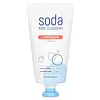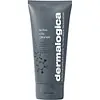What's inside
What's inside
 Key Ingredients
Key Ingredients

 Benefits
Benefits

 Concerns
Concerns

 Ingredients Side-by-side
Ingredients Side-by-side

Water
Skin ConditioningMyristic Acid
CleansingGlycerin
HumectantPotassium Hydroxide
BufferingPalmitic Acid
EmollientPEG-32
HumectantGlycol Distearate
EmollientCocamidopropyl Betaine
CleansingPerlite
AbsorbentStearic Acid
CleansingPalm Kernelamide DEA
EmulsifyingButylene Glycol
HumectantGlyceryl Stearate
EmollientPEG-100 Stearate
Melaleuca Alternifolia Leaf Extract
PerfumingHamamelis Virginiana Extract
AntiseborrhoeicAlcohol
AntimicrobialZea Mays Starch
AbsorbentMicrocrystalline Cellulose
AbsorbentMannitol
HumectantSucrose
HumectantCI 77007
Cosmetic ColorantTocopheryl Acetate
AntioxidantBHT
AntioxidantEthylhexylglycerin
Skin ConditioningDisodium EDTA
Sodium Bicarbonate
AbrasivePhenoxyethanol
PreservativeParfum
MaskingWater, Myristic Acid, Glycerin, Potassium Hydroxide, Palmitic Acid, PEG-32, Glycol Distearate, Cocamidopropyl Betaine, Perlite, Stearic Acid, Palm Kernelamide DEA, Butylene Glycol, Glyceryl Stearate, PEG-100 Stearate, Melaleuca Alternifolia Leaf Extract, Hamamelis Virginiana Extract, Alcohol, Zea Mays Starch, Microcrystalline Cellulose, Mannitol, Sucrose, CI 77007, Tocopheryl Acetate, BHT, Ethylhexylglycerin, Disodium EDTA, Sodium Bicarbonate, Phenoxyethanol, Parfum
Water
Skin ConditioningSodium Cocoyl Isethionate
CleansingGlycerin
HumectantCarthamus Tinctorius Seed Oil
MaskingKaolin
AbrasiveGlyceryl Stearate Se
EmulsifyingPEG-100 Stearate
Propanediol
SolventCoconut Acid
CleansingButylene Glycol
HumectantCharcoal Powder
AbrasiveSodium Astrocaryum Murumuruate
EmollientBrassica Oleracea Italica Extract
AstringentBioflavonoids
Skin ConditioningCitrus Grandis Peel Oil
MaskingPalmitic Acid
EmollientSodium Isethionate
CleansingAloe Barbadensis Leaf Extract
EmollientMelaleuca Alternifolia Leaf Oil
AntioxidantCocamidopropyl Betaine
CleansingTocopheryl Acetate
AntioxidantMyristic Acid
CleansingQuartz
AbrasiveStearic Acid
CleansingEthylhexylglycerin
Skin ConditioningCitric Acid
BufferingO-Cymen-5-Ol
AntimicrobialCetearyl Alcohol
EmollientPolysorbate 60
EmulsifyingPentylene Glycol
Skin ConditioningPolyacrylate Crosspolymer-6
Emulsion StabilisingCaprylyl Glycol
EmollientTetrasodium Glutamate Diacetate
Sodium Hydroxide
BufferingDisodium EDTA
Citral
PerfumingLimonene
PerfumingCI 77891
Cosmetic ColorantWater, Sodium Cocoyl Isethionate, Glycerin, Carthamus Tinctorius Seed Oil, Kaolin, Glyceryl Stearate Se, PEG-100 Stearate, Propanediol, Coconut Acid, Butylene Glycol, Charcoal Powder, Sodium Astrocaryum Murumuruate, Brassica Oleracea Italica Extract, Bioflavonoids, Citrus Grandis Peel Oil, Palmitic Acid, Sodium Isethionate, Aloe Barbadensis Leaf Extract, Melaleuca Alternifolia Leaf Oil, Cocamidopropyl Betaine, Tocopheryl Acetate, Myristic Acid, Quartz, Stearic Acid, Ethylhexylglycerin, Citric Acid, O-Cymen-5-Ol, Cetearyl Alcohol, Polysorbate 60, Pentylene Glycol, Polyacrylate Crosspolymer-6, Caprylyl Glycol, Tetrasodium Glutamate Diacetate, Sodium Hydroxide, Disodium EDTA, Citral, Limonene, CI 77891
Ingredients Explained
These ingredients are found in both products.
Ingredients higher up in an ingredient list are typically present in a larger amount.
Butylene Glycol (or BG) is used within cosmetic products for a few different reasons:
Overall, Butylene Glycol is a safe and well-rounded ingredient that works well with other ingredients.
Though this ingredient works well with most skin types, some people with sensitive skin may experience a reaction such as allergic rashes, closed comedones, or itchiness.
Learn more about Butylene GlycolCocamidopropyl Betaine is a fatty acid created by mixing similar compounds in coconut oil and dimethylaminopropylamine, a compound with two amino groups.
This ingredient is a surfactant and cleanser. It helps gather the dirt, pollutants, and other impurities in your skin to be washed away. It also helps thicken a product and make the texture more creamy.
Being created from coconut oil means Cocamidopropyl Betaine is hydrating for the skin.
While Cocamidopropyl Betaine was believed to be an allergen, a study from 2012 disproved this. It found two compounds in unpure Cocamidopropyl Betaine to be the irritants: aminoamide and 3-dimethylaminopropylamine. High-grade and pure Cocamidopropyl Betaine did not induce allergic reactions during this study.
Learn more about Cocamidopropyl BetaineDisodium EDTA plays a role in making products more stable by aiding other preservatives.
It is a chelating agent, meaning it neutralizes metal ions that may be found in a product.
Disodium EDTA is a salt of edetic acid and is found to be safe in cosmetic ingredients.
Learn more about Disodium EDTAEthylhexylglycerin (we can't pronounce this either) is commonly used as a preservative and skin softener. It is derived from glyceryl.
You might see Ethylhexylglycerin often paired with other preservatives such as phenoxyethanol. Ethylhexylglycerin has been found to increase the effectiveness of these other preservatives.
Glycerin is already naturally found in your skin. It helps moisturize and protect your skin.
A study from 2016 found glycerin to be more effective as a humectant than AHAs and hyaluronic acid.
As a humectant, it helps the skin stay hydrated by pulling moisture to your skin. The low molecular weight of glycerin allows it to pull moisture into the deeper layers of your skin.
Hydrated skin improves your skin barrier; Your skin barrier helps protect against irritants and bacteria.
Glycerin has also been found to have antimicrobial and antiviral properties. Due to these properties, glycerin is often used in wound and burn treatments.
In cosmetics, glycerin is usually derived from plants such as soybean or palm. However, it can also be sourced from animals, such as tallow or animal fat.
This ingredient is organic, colorless, odorless, and non-toxic.
Glycerin is the name for this ingredient in American English. British English uses Glycerol/Glycerine.
Learn more about GlycerinMyristic Acid is a saturated fatty acid. It is naturally found in milk fat. Other sources include palm oil, coconut oil, and butter fat.
Myristic Acid is an emulsifer and cleanser. As an emulsifer, it stabilizes a product by preventing ingredients from separating. Myristic Acid helps clean your skin by acting as a surfactant. It tends to gather oil and dirt on your skin to be easily rinsed away.
One study from 2021 found Myristic Acid to have anti-inflammatory properties.
Learn more about Myristic AcidPalmitic Acid is a fatty acid naturally found in our skin and in many plant and animal sources. In cosmetics, it is usually derived from palm oil. It serves many purposes in skincare, acting as a cleanser, emollient, and emulsifier.
As an emollient, palmitic acid helps soften and smooth the skin by preventing water loss. In cleansers, it helps remove oil and dirt while creating foam.
Its emulsifying properties help stabilize products by keeping water and oil-based ingredients from separating.
This may not be suitable for fungal acne-prone skin, as fatty acids like this can sometimes trigger breakouts in sensitive individuals.
Learn more about Palmitic AcidPeg-100 Stearate is an emollient and emulsifier. As an emollient, it helps keep skin soft by trapping moisture in. On the other hand, emulsifiers help prevent oil and water from separating in a product.
PEGS are a hydrophilic polyether compound . There are 100 ethylene oxide monomers in Peg-100 Stearate. Peg-100 Stearate is polyethylene glycol ester of stearic acid.
Stearic Acid is a fatty acid. It is an emollient, emulsifier, and texture enhancer.
As an emollient, stearic acid helps soften skin. It aids the skin's protective barrier by preventing water loss. It also provides a gentle cleansing effect without stripping away natural oils.
Stearic acid may also be used to enhance the texture of products. It can add volume and stabilize ingredients such as water and oil. This can help water and oil ingredients from separating.
Sources of stearic acid include animal or vegetable fats/oils such as coconut or shea. It can be naturally found in butter, cocoa butter, shea butter, vegetable fats, and animal tallow.
This ingredient may not be Malassezia folliculitis, or fungal-acne safe.
Learn more about Stearic AcidTocopheryl Acetate is AKA Vitamin E. It is an antioxidant and protects your skin from free radicals. Free radicals damage the skin by breaking down collagen.
One study found using Tocopheryl Acetate with Vitamin C decreased the number of sunburned cells.
Tocopheryl Acetate is commonly found in both skincare and dietary supplements.
Learn more about Tocopheryl AcetateWater. It's the most common cosmetic ingredient of all. You'll usually see it at the top of ingredient lists, meaning that it makes up the largest part of the product.
So why is it so popular? Water most often acts as a solvent - this means that it helps dissolve other ingredients into the formulation.
You'll also recognize water as that liquid we all need to stay alive. If you see this, drink a glass of water. Stay hydrated!
Learn more about Water